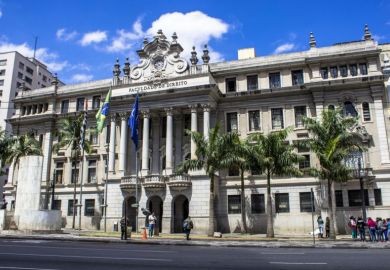Browse the full Times Higher Education Latin America University Rankings 2019 results
Latin America once epitomised public sector monopoly in higher education, with only a few private institutions to speak of. Last year, however, the Program for Research on Private Higher Education (PROPHE), a global scholarly network, released a dataset that showed that the formerly negligible private sector now enrols almost half of all students in that region and one in three students worldwide. In Latin America, the private sector overall has consolidated its position as a viable higher education option, as long as it adopts a non-profit nature, despite much opposition from the public sector.
Although private sector growth is hardly a novelty, higher education has in recent decades faced challenges from a new entrant: private for-profit institutions. For-profits lack legitimacy in the eyes of many in government, industry leaders and much of the general public. Opponents argue that profit distorts the mission of higher education institutions and introduces misguided incentives. Proponents claim that for-profits fulfil a wider public purpose that neither the public nor the private non-profit institutions do.
For-profits earned a tarnished reputation in the US, where some operators’ behaviour sparked a public outcry that, in 2014, prompted Barack Obama’s administration to require for-profits and vocational programmes to prove that they were preparing students for “gainful employment”. Donald Trump’s administration has since sought to revoke this rule.
Although some observers have raised concerns about the quality of education provided by for-profits in Brazil, convenience has mostly won the battle against controversy, at least when it comes to government support. The country’s for-profit sector enrols slightly more than four out of 10 students in higher education, while the private sector overall accounts for more than seven out of 10 students. Despite some efforts to expand public, tuition-free universities during the administration of Luiz Inácio “Lula” da Silva (2003-10), the public sector enrols only a quarter of students.
The vast scale of the for-profit sector in Brazil is not only a matter of enrolment share. As the most powerful economy in Latin America and the ninth globally, Brazil has one of the world’s largest higher education systems, behind only China, India and the US. More than 8 million Brazilians enrol in higher education annually, compared with 3.4 million students in Mexico, 2.9 million in Argentina, 2.2 million in Colombia and 1.2 million in Chile.
Rather than being overlooked by federal administrations in Brazil, the private sector, including for-profits, grew out of government design. First, by the end of the 1990s, Fernando Henrique Cardoso’s administration allowed the establishment of for-profit enterprises in higher education. Many non-profits that had allegedly been behaving as for-profits changed their tax status.
Second, for-profit enrolments skyrocketed during da Silva’s administration. Although his election platform opposed the new private entrants, the policies he introduced in power incentivised for-profits’ growth through the overhaul and expansion of a long-standing student loan programme and the introduction of extensive tax benefits.
Government promotion of the private sector is seen as a convenient, lower-cost way to expand system capacity. In Brazil, public higher education institutions are fully subsidised – students pay no tuition fees – and they have high running costs. Expanding access through the more prestigious, research-intensive public sector is three times costlier than it is through private institutions.
Lately, many are voicing concerns about the growth of large, publicly traded home-grown education companies. Estimates indicate that the 10 largest Brazilian for-profit companies enrol about 40 per cent of the private sector students in the country. One of the largest, Kroton Educacional, surpasses the well-known US-based for-profit provider Laureate Education in terms of net income.
Recently, Brazil’s antitrust agency rejected a merger proposal between Kroton and Estácio, the country’s second largest for-profit provider, citing market competition issues. Some observers wonder to what extent the growth of these corporations may show a trend towards declining quality of higher education. Notably, these companies are taking advantage of the financial crisis to buy free-standing institutions or to absorb smaller companies. As the operators expand, they could become a hindrance to the federal government’s ability to properly regulate the sector.
However, regardless of the controversy caused by this new player, by and large for-profits in Brazil serve a demand that the public sector has not been able to meet, and they seem to have settled into the higher education landscape.
Dante J. Salto is postdoctoral fellow at the Institute of Humanities at National University of Cordoba.
Register to continue
Why register?
- Registration is free and only takes a moment
- Once registered, you can read 3 articles a month
- Sign up for our newsletter
Subscribe
Or subscribe for unlimited access to:
- Unlimited access to news, views, insights & reviews
- Digital editions
- Digital access to THE’s university and college rankings analysis
Already registered or a current subscriber?







